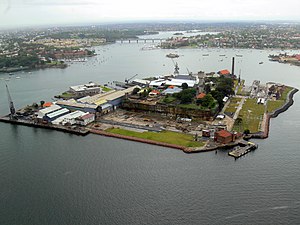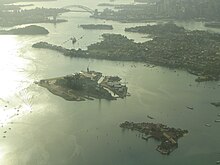Cockatoo Island (Sydney)
| Cockatoo Island | ||
|---|---|---|
| Panorama of Cockatoo Island | ||
| Waters | Parramatta River | |
| Geographical location | 33 ° 50 '49 " S , 151 ° 10' 16" O | |
|
|
||
| surface | 18 ha | |
| Cockatoo Island viewed from Gladesville Bridge | ||
Cockatoo Island is the largest island on Sydney Harbor in New South Wales , Australia . It is located at the confluence of the Lane Cover River in the Parramatta River .
On Cockatoo Iceland there was a penal colony , a prison, reformatory, craft and religious school for girls and the two largest shipyards in Australia. The shipyards were closed in 1992 and the island in July 2010 the UNESCO - World Heritage listed. Today Cockatoo Island is rated as an example of Australia's development from a convict colony to an industrial maritime nation.
The island is administered by the Sydney Harbor Federation Trust , which is responsible for structural measures for the protection of monuments and nature in the Sydney harbor area. The Trust opened the island for cultural activities after 2005, such as the Cockatoo Island Festival and the Biennale of Sydney .
Surname
In the early years the island was named Biloela , after the name of the Aborigines for the black cockatoo (German: Schwarzer Kakadu ). Officially, the island was named Government Dockyard - Biloela until 1913 and then Commonwealth Naval Dockyard, Cockatoo Island . The name Biloela was then used as the name for ships that were built in the dry docks, but including a ship named after the city of the same name in Queensland .
Early history
Before the British colonization, the island was in the hands of the traditional landowners, the Eora , who lived in the Sydney Basin area . In the Eora language, Cockatoo Island is known as Wareamah , which is made up of the words was (woman) and eamah (land). It is believed that the island was used for ceremonial purposes by or for women.
In 1839 a prison was built on the island by the governor George Gipps and was used until 1869. The convicts had to work hard in Sydney, for example they created Circular Quay in Sydney and excavated the Fitzroy dry dock on the island with a size of 42,000 m³, Australia's first dry dock. Children aged 10 to 14 were also brought there.
Dry docks
FitzRoy dry dock
The Fitzroy dry dock with a length of 316 m and width of 76 m was built from 1847 to 1857 in detention under the supervision of the engineer Gother Kerr Mann. The foundation stone was laid on June 5, 1854 by Governor Charles Augustus FitzRoy , after whom it is named. It was lengthened to a length of 643 m in 1870 and 1880. The first ship to be drained was the HMS Herald , which passed through the 18 m wide gate of the dock.
Sutherland dry dock
The engineer Louis Samuel built the Sutherland Dock from 1882 to 1890. The dock provided space for ships with a tonnage of up to 20,000 tons. In 1913 and 1927 the dock was made available for Royal Australian Navy ships .
In 1864 the island administration was split between the Department of Prisons and the Public Works Department of New South Wales. In 1869 the convicts were taken to Darlinghurst Gaol and the prison building was used as a craft school for girls and for religious education.
Cockatoo Island dry dock
In 1870 shipbuilding began on Cockatoo Island in the Cockatoo Island dry dock.
In 1913 the Commonwealth, the Australian Government, took over the island and made the dry dock the Naval Dockyard of the Royal Australian Navy . The government's first order was to arm the Warrego torpedo boat . During the First World War , the dry dock was used to build and repair warships. About 4,000 people were employed there at the height of the war.
In 1933 the island was leased to Cockatoo Docks and Engineering Company Ltd for a period of 21 years, in 1954 for an additional 20 years and in 1972 for an additional 21 years. The Steam Tug Wattle (1933), HMS Yarra (1934), HMAS Vigilant (1938), HMAS Arunta (1940), HMAS Warrego (1939), HMAS Wollongong , HMAS Warramunga (1942) and HMAS Bataan (1944) were built. During the Second World War , the dock was the most important repair shop in the southwestern Pacific with around 250 repaired and converted warships . Between August 1942 and March 1943 the warships of the United States Navy USS Chicago , USS Chester , USS Portland and USS New Orleans were repaired after combat damage and other ships of the Royal Australian Navy such as the HMAS Hobart after torpedo hits.
After the war, both civilian and warships continued to be built, such as the Empress of Australia ship ferry and the warships HMAS Success , HMAS Vampire (1952), MAS Stalwart (1968) and submarines. The HMAS Success was the last ship to be launched in 1984.
Convict colony and monument protection
In July 2010 the island was inscribed on the UNESCO World Heritage List as one of eleven places that were important for the life of convicts. The reserve covers the entire island with 18 hectares in Sydney Harbor between Birchgrove Point and Woolwich Point . In addition to being on the UNESCO list of historical monuments, the island is also registered in the national and New South Wales.
Cockatoo Island is historically significant as it is the only remaining dry dock from the time when Australia was a convict colony that bears witness to the treatment, incarceration and working and living conditions of the convicts, which total 580,000 m³ to a depth of Hit 14 m out of the surrounding Hawkesbury sandstone rock .
The island also bears witness to the development of ship dismantling and heavy industry in Australia since the mid-19th century.
The historical buildings that have been preserved include the prisoners' quarters, hospital, canteen, military and officer quarters, quarters for free settlers from overseas and the superintendent's cottage.
The power station, which was built in 1918, represents the largest collection of Australian equipment for electrical, hydraulic energy and pump construction.
Culture
Since the island was taken over by the Sydney Harbor Federation Trust , the island has become a major cultural venue for artistic events.
In 2005, the three-day music and artist festival Cockatoo Island Festival took place with more than 20,000 visitors and over 120 music and other events. The festival was not repeated in this form, but as The Great Escape in 2006.
In 2007 an event by the installation artist Urs Fischer was held.
In 2008 the Biennale of Sydney took place with around 86,000 visitors over an exhibition period of ten weeks and again in 2010 with 157,000 visitors.
In 2009 the island hosted the Sydney Festival, with 12,000 visitors and Ken Unsworth showed installation art that same year . The World's Funniest Island Comedy Festival was also held, which attracted 8,000 visitors. The Urban Island Masterclass showed artistic representation of the island.
In 2010 the Underbelly Festival was held with a duration of 10 days.
In 2011 the Red Bull X-Fighters World Tour Final took place as a freestile motocross event, as did another event by Ken Unsworth.
reachability
The island can be reached by ferry and there is a campsite.
Web links
- Entry on the UNESCO World Heritage Center website ( English and French ).
- cockatooisland.gov.au : Cockatoo Island website
- harbourtrust.gov.au : Sydney Harbor Federation Trust Sites - Cockatoo Island
- nla.gov.au : Aerial photography by Frank Hurley in the National Library of Australia
Individual evidence
- ↑ cockatooisland.gov.au ( Memento of the original from February 27, 2012 in the Internet Archive ) Info: The archive link was inserted automatically and has not yet been checked. Please check the original and archive link according to the instructions and then remove this notice. : Heritage , accessed December 14, 2011
- ↑ naa.gov.au : The history of Cockatoo Island Dockyard , in English, accessed December 14, 2011
- ^ The story of Cockatoo Island First Nations. In: cockatooisland.gov.au. Retrieved July 4, 2020 .
- ↑ naa.gov.au : Fitzroy dock , in English, accessed December 14, 2011
- ↑ naa.gov.au : Sutherland dock , in English, accessed December 14, 2011
- ↑ whc.unesco.org : Australian Covict Sites , in English, accessed December 14, 2011
- ↑ a b environment.gov.au ( Memento of the original from March 21, 2012 in the Internet Archive ) Info: The archive link was inserted automatically and has not yet been checked. Please check the original and archive link according to the instructions and then remove this notice. (PDF; 130 kB): Cockatoo Island , in English, accessed on December 14, 2011
- ↑ environment.gov.au : Cockatoo Island, New South Wales , in English, accessed December 14, 2011
- ↑ urbanislands.net : URBAN ISLANDS 2009 , in English, accessed on December 14, 2011



